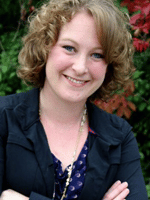This October during National Chiropractic Health Month, the American Chiropractic Association and doctors of chiropractic nationwide are working together to promote better access to non-drug therapies and remind people that chiropractic’s non-drug approach is on the frontline for pain management, offering evidence-based treatments that are safe and effective and that may help some patients to reduce or eliminate their dependence on prescription opioids. On the Healthy Living blog this month, we are sharing the stories of chiropractors who are “On the Frontline for Pain.”

Therese Miller, DC, is a chiropractor who specializes in occupational health. Trained in Active Release Technique (ART), she works as an independent contractor with ART Corporate Solutions, providing treatment onsite in a range of industries to improve employee health and reduce OSHA and workers’ compensation reportable injuries. She is also the founder and president of Linchpin Health, which provides employee safety trainings to educate and empower employees regarding occupational health and injury prevention.
Q: What does a “day in the life” look like in your job?
A: I have two different sides: from the ART side, employee treatment schedules are maintained by the Employee Health and Safety personnel on site, so they book any appointments. ART works with a range of companies from manufacturing, which requires a lot of physical work and repetitive motion, to traditional office settings, where employees sit at desks for most of the workday. Regardless of an occupation’s requirements, ART treatment helps employees feel better faster, increases productivity, and boosts morale. We go after aches and pains before they become bigger injuries. We make big progress in a short amount of time—within three to four 15-minute visits, patients are released. It’s great; from the patient standpoint, they get services that are paid for by their employer, and they get to take care of those aches and those pains—things that are chronic or that are just bugging them—before they become a bigger problem. It’s awesome to see companies taking care of their employees from a preventative standpoint.
Q: Why did you want to become a chiropractor, and how did you end up working in occupational health?
A: I always knew I wanted to go into medicine. I was an athlete through college and had some major injuries. I was exposed to chiropractic when I had a hip injury—my orthopedic surgeon sent me to a chiropractor to try to help with my pain and get me through my athletic season. The chiropractor started working on my feet and ankles and didn’t go anywhere near my hip. I thought it was crazy, but it ended up reducing my hip pain. The problem actually stemmed from the fact that previous injuries in my ankles and feet were causing me to compensate and use my hip more than I should. It opened a whole new world of how the body is interconnected. I took a year off after college and shadowed different healthcare providers, and the one thing about chiropractic that really stirred me was the fact that it not only has an open scope of practice in most states, but it has a different approach: instead of just trying to band-aid symptoms, we try to get at the root issues and do more education to help the patient advocate for themselves and take their health into their own hands. I found that unique across the healthcare professions.
Q: What type of injuries or pain do your patients experience?
A: It is a whole gamut. It depends on the company—there are many employees who are lifting a lot during the day, so we see a lot of low back and shoulder issues from the lifting. I have a lot of forklift drivers who get neck issues because they constantly must turn and look around them. I see a lot of foot problems like plantar fasciitis because workers are in steel-toed boots, which don’t allow the foot to function properly. It largely depends on the individual company; most of it is related to repetitive strain. It’s not necessarily that they’re lifting a 500-pound box and that’s how they got hurt, it’s that they’re bending two pounds of wire but they’re doing it 70 times over the course of the day. It’s that repetition that tends to be the problem or holding positions for a long period of time.

Q: How do chiropractors help corporate and industry workers?
A: Two different sides again: With ART, it is a hands-on, preventative approach. As soft-tissues become overloaded from repetition, they become less pliable and/or tighter, which increases risk of further injury. Using this hands-on technique, we can improve tissue pliability and function before larger injuries occur. We can also develop general stretching programs, etc., for the facilities as needed.
From the other side, with Linchpin Health, it’s the education piece. If you are just a worker going to work every day, you don’t think about what that does to your body after a year, three years, 30 years on the job. You don’t know what to change or that you should be preventative. Unfortunately, most people have the mindset of, “If it’s not broken, I’m not going to go pay money or go in.” Educating people to seek care earlier helps them understand that when they’re having that ache and pain, earlier treatment can actually save them time and money in the long run.
Q: What makes the chiropractic approach different?
A: I think it’s the broad base of tools that chiropractors pull in. We can go anywhere from nutrition to lifestyle to body mechanics to ergonomics. The broad scope of our knowledge base and tools is really unique. I also think it’s that deep-down philosophy of going after the root problem. It’s important to get the person out of pain, but it’s more important to help them understand what might prevent it from coming back—to make sure you’re taking care of the whole person, not just the symptom. Those two things make chiropractors unique.
Q: Why is it important for industry and corporate workers to have access to non-drug pain management options?
A: I think for a long time drug options are all people have known, and I don’t think [non-drug options] are frequently viewed in our society as being as effective as they can be or as being readily available. There are always barriers: I have to find a provider I trust, or I have to take time off work to go to the clinic. It’s really important that patients have access to these options, removing as many of those barriers as possible so that it becomes a tool they trust and they know can be effective. There’s a place for every treatment, but it’s important that we put it out there that there are options before you get to that medication.
Q: What does it mean to you to be “on the frontline for pain”?
A: For me, it means I have an opportunity to change health care long term. I have an opportunity to help employees across various industries look at their health care differently, ask different questions, maybe pursue non-drug options more readily than they might have been able to, so it’s a great opportunity to impact health care.
From the patient side, I think it’s a great opportunity for them to educate themselves, become their own advocates, start to learn more, and feel better about asking questions about their health. I think that’s becoming more and more important to people.
Q: What is one thing that the public should know about chiropractic?
A: Chiropractors, like many different professions, have a lot of different tools. So just because you go to one chiropractor and it doesn’t work or their tools aren’t the right fit for you, it’s important to recognize that, as a profession, we have this amazing toolbox to treat so many different things in a drug-free way, and it’s all about finding the right tool for your current situation.
There used to be a mindset of either/or in terms of, “I’ll go see this traditional medical doctor OR I’ll go see this alternative provider.” I want to encourage people that it’s not “either/or” anymore, it’s very much AND. You can tap into chiropractic services and still see your primary care—you should tap into both. You should find providers that encourage communication across multiple disciplines. All those providers offer different perspectives and different tools.



